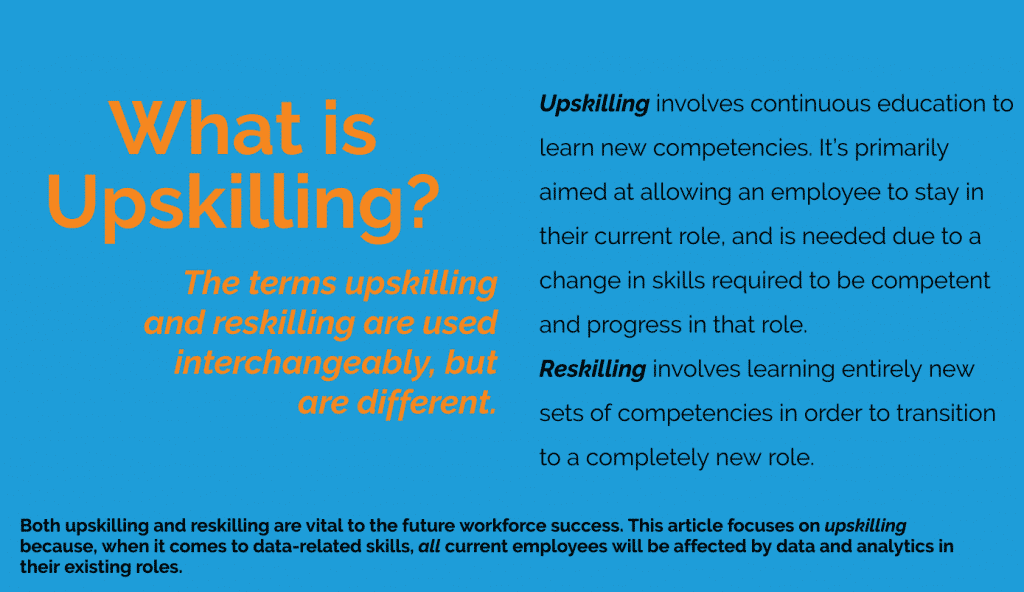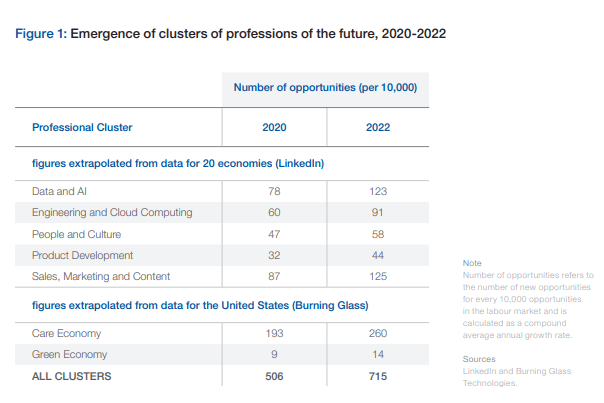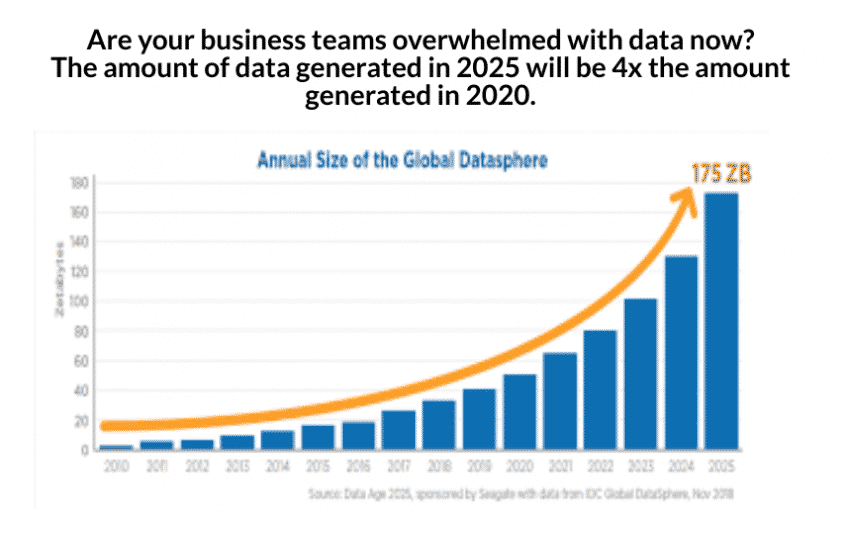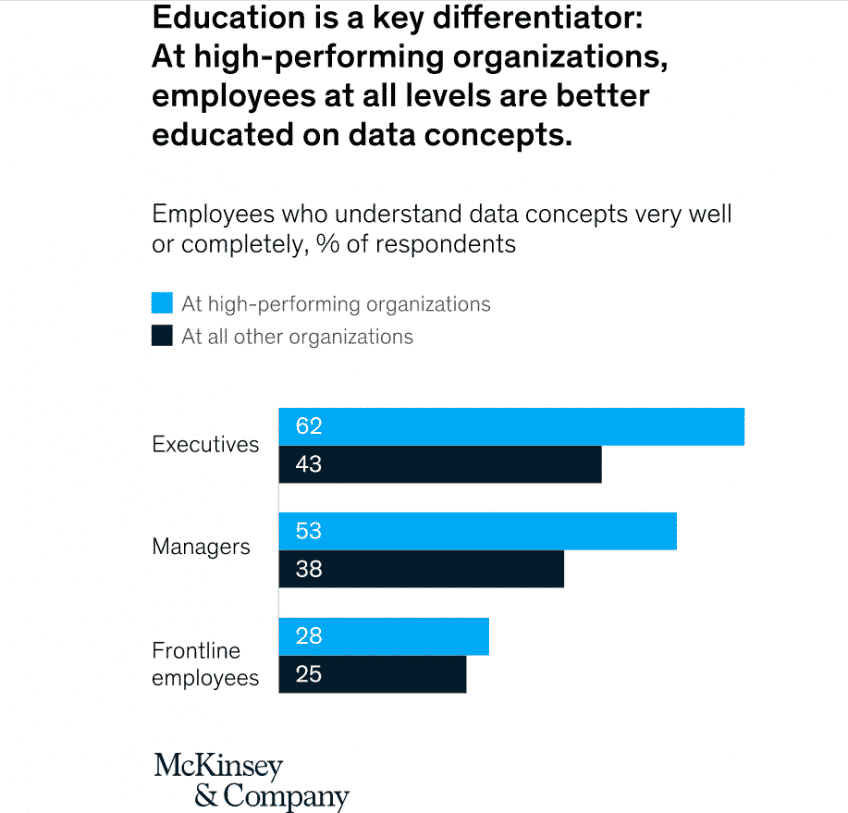(5 minute read)

The Future Workforce
In its 2018 Future of Jobs Report, the World Economic Forum (WEF) predicted that by 2022, the Fourth Industrial Revolution will create 133 million new jobs. Concurrently, it will render 75 million jobs obsolete in the large enterprise subset alone.
Multitudes of employees who lack requisite new skills, including data analytic skills, will be displaced in the process.
The World Economic Forum, Accenture, and a host of global organizations and experts say that “Industry 4.0” is upon us. This industrial revolution entails accelerating, ongoing technological changes including digitization, automation, and AI, new disruptive business models, and increasing business complexity.
These changes will produce a profound transformation in both the type and nature of future jobs and in the structure of the workforce. New skillsets will be needed for existing job occupations, while other traditional jobs and skillsets will simply become unnecessary.
From low skilled jobs to high expertise roles, this technological transformation will impact the entire workforce.
The Upskilling Imperative
With this scenario at hand, the WEF cautions,
“To prevent an undesirable lose-lose scenario—technological change accompanied by talent shortages, mass unemployment, and growing inequality—it is critical that businesses take an active role in supporting their existing workforces through reskilling and upskilling, that individuals take a proactive approach to their own lifelong learning.”
According to the WEF, 54% of current employees will require significant reskilling and upskilling by 2022. Of those needing new skills, 35% will require additional training of up to 6 months – the rest, longer.
Companies will thus have to retrain and redeploy millions of mid-career employees. To this point, McKinsey Global Institute notes,
“There are few precedents in which societies have successfully retrained such large numbers of people.”[i]
Some leading corporations are beginning to recognize the importance of upskilling and reskilling employees to cope with the changing nature of work roles and processes over the coming years. JP Morgan, Accenture, and AT&T have collectively pledged over $1.5 billion to upskill their employees in line with the future of work requirements. Amazon has pledged to upskill a third of its workforce.
However, across industries and economies, a vast number of companies lag indecisively when it comes to investment in retraining their employees.
Yet, 2022 is just around the corner. Organizations do not have the luxury of a decade, or even a few years, as was the case in previous Industrial Revolutions, to adapt their workforce. The speed of change today is just too fast.
Companies must start preparing their workforce for the future now.

Why Upskilling Data and Analytics Competency is Critical
In its three most recent reports on the future of jobs, including 2020’s Jobs of Tomorrow: Mapping Opportunity in the New Economy, the WEF identified that the “new labor market” will be driven to a significant degree by advances in data science and artificial intelligence.
The WEF identified “Data and AI” as an umbrella for a large cluster of new jobs to be created in the future. The WEF predicts that “data and AI” will create about 400,000 new jobs by 2022.
Figure 1 below from the WEF 2020 report shows the number of new job opportunities that will be created per 10,000 jobs in high growth job clusters. Data and AI ranks 3rd behind the “Care Economy” (healthcare) and Sales, Marketing, and Content.

What’s important to understand, though, is that several of these fast-growing job clusters, including Sales, Marketing and Content, People and Culture, the Care Economy, and the Green Economy, are moving towards a heavier data and analytics focus.
For instance, the #1 upskilling course on Coursera (which collaborated with the WEF on this study), Digital Marketing, teaches data analysis, marketing analytics, and general analytics as core skills. Even though Digital Marketing jobs fall under the Sales, Marketing, and Content job category, they still require analytics skills.
The new job opportunities that require data analytics skills will be more widespread than in just the Data and AI field.
In reality, some 2 million new jobs in other new job growth clusters identified by the WEF will be impacted by analytics.
10 Trends Driving the Need to Upskill for Data Concepts
1. Data and analytics are ubiquitous

Over the last decade, big data was largely viewed as a by-product of digital applications and platforms. Companies focused primarily on how to store, clean, and manage data securely.
Now companies are focusing on data as “the new oil”. They view it as an asset that must be further broken down and refined through data science and analytics to generate profits.
The challenge is that data is everywhere, and the volume of data is skyrocketing as the graph to the right from IDC shows.
We’re only at the tip of the iceberg when it comes to the volume of data that will be created and which will need to be analyzed for business purposes.
Currently, firms are just scratching the surface of what can be done with all this data. WEF found that in 2019, in the US, some 89% of companies planned to adopt user and entity big data analytics. More data skills will be needed to profit from the pervasive volumes of data.
2. Artificial Intelligence
The World Economic Forum (and just about everyone else) made it clear that artificial intelligence would be a huge factor, if not the biggest, driving the need for upskilling the workforce.
Not only will a significant part of the workforce be displaced by AI (think Amazon warehouse packers), but AI will also become part and parcel of corporate, business unit and functional strategy and operations. This includes new business model teams to the legal department and right down to the manufacturing floor.
3. Data-driven performance
“Healthy data cultures empower people to make better decisions, create open discussions, and ultimately leads to the kind of superior innovation that is necessary for businesses to remain competitive and agile.” –
Helena Schwenk, Market Intelligence at Exasol.
A recent study from analytics database company Exasol, found that 65% of data teams have experienced employee resistance to the adoption of data-driven methods. This is primarily because employees and managers lack a fundamental understanding of data and the positive impact that data contributes.

The majority of executives and managers at high performing companies have data skills.
McKinsey data shows that these “laggard” companies, whose employees and managers are lacking education on data concepts, are falling behind on performance. High performing organizations attribute at least 20% of their EBIT to the use of data analytics. Furthermore, the gap in performance between companies with a data-educated workforce and those lacking in data skills growing wider every year.
The literal bottom line is that upskilling employees to understand data concepts pays. It may even be a requirement for long term survival.
4. The talent shortage
“The urgency for upskilling comes at a time when emerging skill sets (like data science) are scarce and the talent market is tight – making it prudent to keep people even if they don’t have the right skills now.”
– Michael Hughes, Managing Director, West Monroe Partners.
Companies currently face numerous challenges operationalizing the innovative, consistent use of data, and are looking to develop more data analytics and intelligence capabilities. They currently face a challenge finding the necessary talent to achieve their objectives.
Although organizations are trying to become more data-driven, data science and analytics initiatives are being held back by a shortage of data talent, whether it be due to a hyper-competitive job market, high salary demands or prolonged time to fill data-related roles.
What’s more, even with efforts made by educational institutions to churn out new graduates armed with analytics degrees, it seems insufficient to fill the talent gap.
According to Josh Bersin, universities underestimate the demand for technical skills by 300% and they are twice as confident about the workforce skills they are generating as employers. There’s a continued disconnect between talent creation through education and the technical talent employers actually need.
The result is that demand for data science and analytics talent still outstrips supply. Upskilling and reskilling employees can help companies build the internal pool of data science and analytics talent they require and make them less reliant on expensive, hard to hire, talent.
5. The skills gap
The figure below, taken from a 2019 KPMG CIO survey shows that data and analytics skills remain in chronic shortage. Likewise, a Teradata survey found that 50% of business decision makers face a data skills gap and are calling for more training in data and analytics.

KPMG 2019 CIO Survey Results
One reason for the skills gap is that to do the job of a Data Scientist or other analytics professional, or, to work with business analytics as a functional employee, a wide variety of skills is needed. The ideal person for these roles is often described as having “T shaped” skills.
This means that an analytics professional ideally has highly specialized skills in one or two areas, such as data science, programming, or domain expertise, and also adjacent skills, such as critical thinking, communication, and visualization skills. In the current job market, this is a challenging profile to find.
Further exacerbating the skills gap is the ever-expanding nature of analytics into new fields. Take the example of a government agency such as a state wildlife department. The agency might use data and analytics in order to analyze customer interactions, help serve constituents, generate revenue for funding recreational activities and conserving natural resources. It’s unlikely that many wildlife department employees are adept at business analytics.
In perhaps the most significant acknowledgment of the chronic technical skills gap, Amazon announced in 2019 its Upskilling 2025 Pledge to spend $700 million retraining non-technical employees for data, analytics, and technical roles such as healthcare analytics, machine learning, and computer science.
6. The Internet of Things (IoT)
IoT is expected to generate more diverse and exponentially extensive datasets, creating an unprecedented challenge to companies seeking to unlock value from this new data in order to maintain a competitive advantage. Currently, the duty of unlocking value from huge datasets falls largely on the shoulders of highly specialized Data Scientists.
The volumes of future data generated by IoT will simply become too big for advanced analytics teams to shoulder alone.
In Retail, expenditure on IoT technology aimed at improving customer experience and logistics management is expected to grow 20% p.a. to reach more than $35 billion by 2020.
Likewise, increasing demands for transparency and traceability of products will see IoT solutions drive data generation, collection, and analysis throughout the entire manufacturing process and supply chain, resulting in a doubling of IoT technology expenditure by 2025.
There’s simply not enough data science talent out there to wrangle value out of all this data.
Some of the heavy lifting will have to be shouldered by business users, such as manufacturing equipment managers or regional sales teams. These employees will need to become comfortable dealing with data and thinking in terms of data analytics.
This brings us to the next trend.
7. Self-service data analytics
The market has responded to the lack of Data Scientists and data engineering talent with automated platforms that allow nontechnical business users to engage in the exploration of data and the discovery of data-based insights. Many of these platforms provide data science features that, without education on data concepts, may go unused or be misused.
To operate these platforms, business users will need to understand data concepts such as data visualization, correlations and clusters, and data discovery.
8. Cross-functional teams
Data science is now recognized as a team sport. It’s become very clear to most companies that in order to achieve data science objectives and enlist the diversity of skills that data project teams need, these teams must be cross-functional.
Everyone on the team needs to be conversant in data concepts, including business and functional team members.
9. Data literacy initiatives
“By 2020, 50% of organizations will lack sufficient AI and data literacy skills to achieve business value.”
– Gartner, Inc.
It would appear that some companies have begun to notice Gartner’s warning. According to Metis and Burtch Works, demand for data-related skills and talent is exploding at the less “technical” end of data skills, otherwise known as “data literacy” skills.
These skills include knowledge of data terminology, understanding of use cases, data project scoping, data project lifecycle management, and so forth. Demand for data literacy skills could also mean, for example, adding Python skills to a functional area (such as sales) skill set in order to broaden their tool kit.
Whatever the role, the ability to speak the language of data will become integral.
10. The bottom-line cost
According to the WEF, the average cost of hiring a new employee is $4,425. Data from the Association for Talent Development shows the average cost of upskilling an existing employee is just $1,300.
Even if you were to double this figure to account for the technical complexity of skills related to data and AI, companies are likely to come out ahead financially by upskilling existing employees.
With the high costs of Data Scientist salaries, the extended time to hire Data Scientists, and the high turnover cost of a bad data science hire, it is likely much cheaper to retrain existing employees. The added benefit to retraining the workforce is that existing employees are already loyal, have domain and business knowledge, and fit into the company culture.
By retraining employees to be data literate, companies get more bang for their buck.
So What Now?
All evidence points to an explosion demand for data, analytics, and AI skills beyond 2025 and a chronic lack of data talent and skills that shows no signs of ending. The solution, according to many experts and thought leaders, is to begin upskilling your workforce now.
The question then is, who should be upskilled, when, how, and for what skills?
The answer to this question is just beginning to emerge in 2020. We’re starting to have conversations with HR and Data leaders on these very topics. We’ll address them in future articles.
[i] McKinsey Global Institute, “Jobs Lost, Jobs Gained: Workforce Transitions in a Time of Automation”. December, 2017.